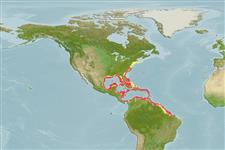>
Eupercaria/misc (Various families in series Eupercaria) >
Lutjanidae (Snappers) > Lutjaninae
Etymology: Lutjanus: Malay, ikan lutjan, name of a fish.
More on author: Cuvier.
Environment: milieu / climate zone / depth range / distribution range
Écologie
marin récifal; profondeur 20 - 200 m (Ref. 9626), usually 80 - 150 m (Ref. 55). Subtropical; 43°N - 3°S, 100°W - 38°W (Ref. 55227)
Western Atlantic: as far north as North Carolina, USA and Bermuda south to Trinidad and northern Brazil; including the Gulf of Mexico (Ref. 9626). Very common in the Caribbean, particularly the Antilles.
Length at first maturity / Taille / Poids / Âge
Maturity: Lm 28.7, range 21 - 25 cm
Max length : 75.0 cm TL mâle / non sexé; (Ref. 9710); common length : 50.0 cm TL mâle / non sexé; (Ref. 55); poids max. publié: 14.0 kg (Ref. 9710)
Épines dorsales (Total): 10; Rayons mous dorsaux (Total): 14; Épines anales 3; Rayons mous anaux: 8. Preopercular notch and knob weak. Scale rows on back rising obliquely above lateral line. Mainly scarlet red, silvery on lower sides and belly; fins are yellowish to orange. A prominent black blotch is at the base and in axil of pectoral fins.
Adults inhabit deeper waters over sandy or rocky bottoms and near drop-offs and ledges. Young occur in shallower water, often between about 35 and 50 m. Feed mainly on fishes. Good food fish, it is marketed mostly fresh (Ref. 55).
Life cycle and mating behavior
Maturité | Reproduction | Frai | Œufs | Fécondité | Larves
Allen, G.R., 1985. FAO Species Catalogue. Vol. 6. Snappers of the world. An annotated and illustrated catalogue of lutjanid species known to date. FAO Fish. Synop. 125(6):208 p. Rome: FAO. (Ref. 55)
Statut dans la liste rouge de l'IUCN (Ref. 130435)
Menace pour l'homme
Reports of ciguatera poisoning (Ref. 55)
Utilisations par l'homme
Pêcheries: commercial
Plus d'informations
RéférencesAquacultureProfil d'aquacultureSouchesGénétiqueElectrophoresesHéritabilitéPathologiesTraitementNutrientsMass conversion
Outils
Articles particuliers
Télécharger en XML
Sources Internet
Estimates based on models
Preferred temperature (Ref.
123201): 18 - 26.2, mean 22.3 °C (based on 64 cells).
Phylogenetic diversity index (Ref.
82804): PD
50 = 0.5000 [Uniqueness, from 0.5 = low to 2.0 = high].
Bayesian length-weight: a=0.01479 (0.01312 - 0.01667), b=2.97 (2.95 - 2.99), in cm total length, based on LWR estimates for this species (Ref.
93245).
Niveau trophique (Ref.
69278): 3.9 ±0.57 se; based on food items.
Résilience (Ref.
120179): Milieu, temps minimum de doublement de population : 1,4 à 4,4 années (K=0.10-0.70).
Fishing Vulnerability (Ref.
59153): High vulnerability (62 of 100).
Nutrients (Ref.
124155): Calcium = 17.7 [9.4, 27.6] mg/100g; Iron = 0.317 [0.183, 0.541] mg/100g; Protein = 19.3 [17.8, 20.7] %; Omega3 = 0.214 [0.132, 0.353] g/100g; Selenium = 40.5 [22.1, 74.1] μg/100g; VitaminA = 56.3 [10.1, 268.9] μg/100g; Zinc = 0.248 [0.178, 0.379] mg/100g (wet weight);
